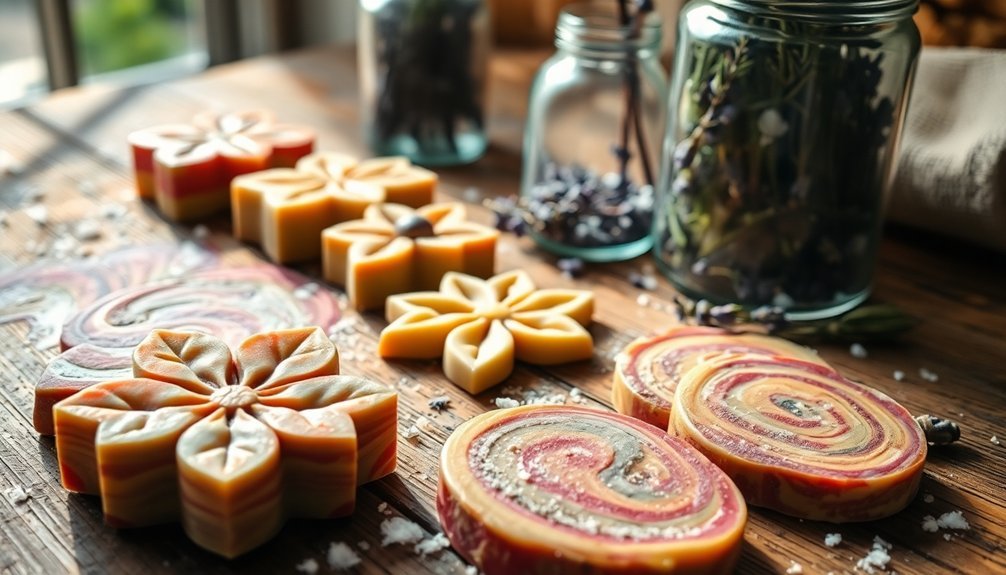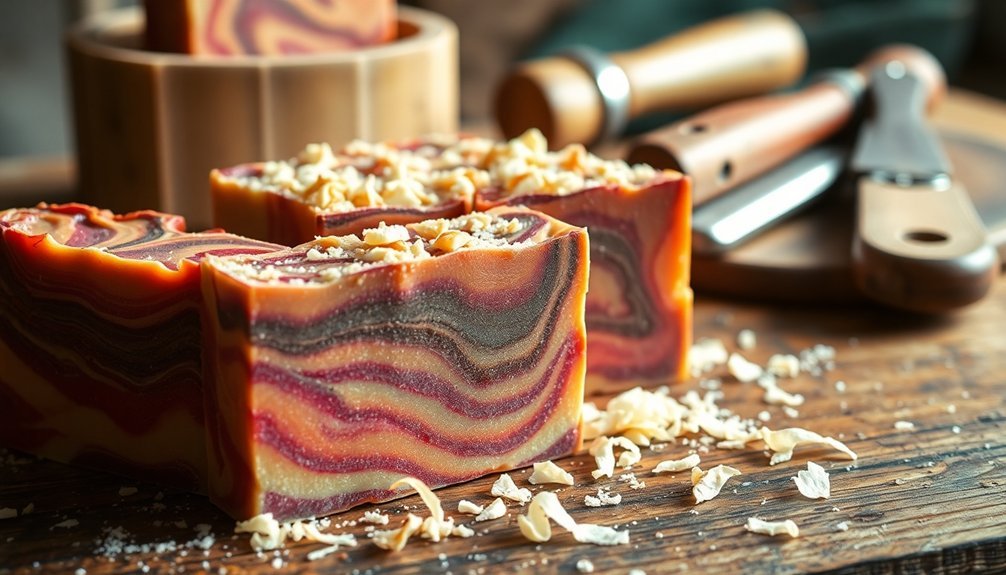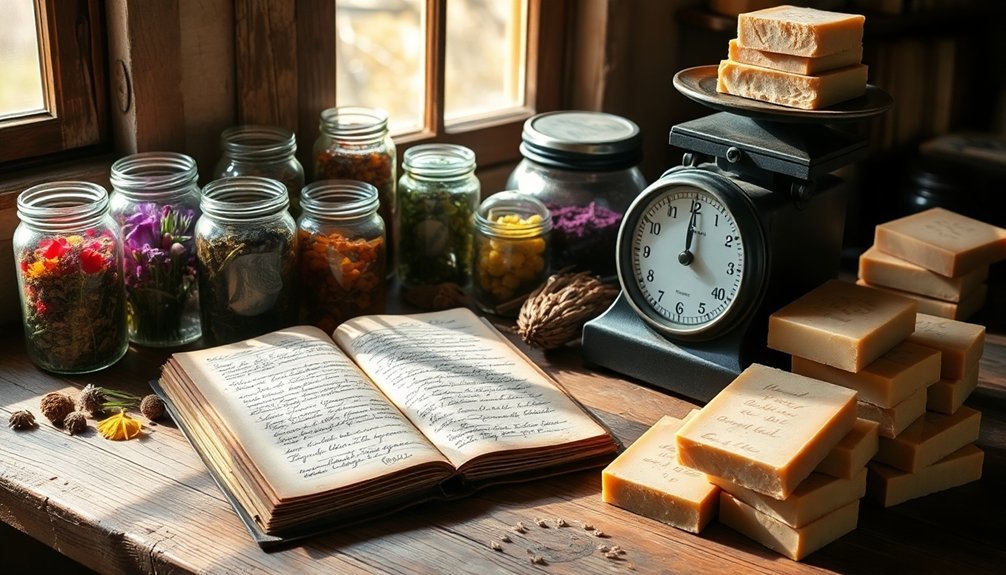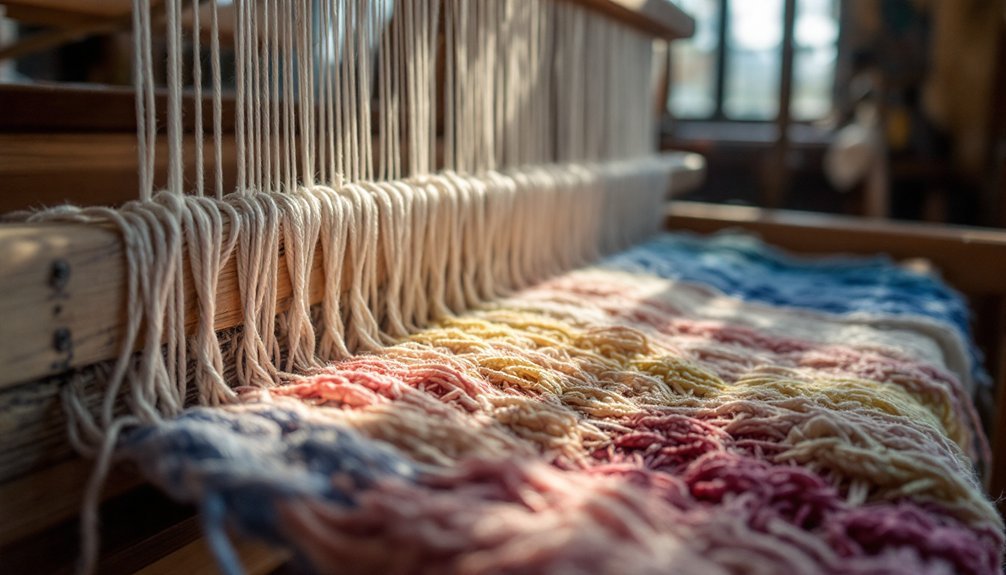Five heritage craft methods that continue to captivate artisans include cold process soap making (dating back to 2800 BCE), botanical soap infusions using traditional herbs, hand-cut soap techniques that showcase craftsmanship, natural colorant preparation methods using plants like indigo and henna, and family soap recipes passed through generations. These methods connect you to thousands of years of human ingenuity and sustainable practices. Explore these time-honored traditions to discover how ancient wisdom enhances modern crafting.
The Ancient Art of Cold Process Soap Crafting

While modern store shelves overflow with mass-produced detergent bars, cold process soap crafting remains a cherished heritage skill with roots stretching back nearly 5,000 years. The Babylonians pioneered this art around 2800 BCE, combining fats with alkaline salts, while Romans later refined and popularized it for personal hygiene.
Ancient wisdom lives on in every bar, connecting modern soap artisans to centuries of handcrafted tradition.
Today, you'll find the process remarkably similar to these ancient methods. You'll begin by carefully mixing lye with water, then combining it with melted oils until reaching the vital "trace" stage. Safety is paramount during this process, so always wear protective equipment including goggles, gloves, and an apron.
After pouring your creation into molds, patience becomes essential during the weeks-long curing process.
The reward? Custom soaps tailored to your skin's needs, free from harsh chemicals, and crafted with eco-friendly ingredients. Each bar becomes both a practical tool and artistic expression of an enduring craft.
From Plant to Pot: Traditional Botanical Soap Infusions
Beyond the basic cold process method lies a vibrant world of botanical enrichment that transforms ordinary soap into therapeutic treasures. You'll find herbs like lavender, chamomile, and calendula offer not just fragrance but genuine medicinal benefits that soothe skin irritations.
When crafting botanical soaps, you can choose between several infusion methods. Hot infusion works quickly but may diminish some herbal properties, while cold infusion preserves delicate plant compounds. Proper documentation of your experiment results serves as primary sources for future reference and improvement in your soap-making process.
The window sill technique harnesses natural sunlight for weeks, creating potent extracts without artificial heat.
You can incorporate these botanicals by replacing regular oils with infused alternatives, using herbal teas in your lye water, or adding dried herbs directly to your soap batter.
Remember to wear proper safety equipment whenever working with lye.
Hand-Cut Techniques in Artisanal Soap Production

After your soap loaf has properly cured, the artistry of hand-cutting transforms a humble block into individual bars of character and distinction. This process, typically performed after 24-48 hours of curing, requires precision and care while wearing protective gloves to guard against lye residue.
You'll find various tools at your disposal—straight knives for clean edges, soap cutters for uniformity, and wavy cutters for textured, non-slip surfaces. Each cut represents a connection to soap-making heritage that spans generations and cultures. Consider hand milling techniques to salvage imperfect bars or scraps that result from the cutting process, eliminating waste.
The slight irregularities in your hand-cut bars aren't flaws but signatures of craftsmanship. They enhance the rustic appeal that distinguishes artisanal products from mass-produced alternatives, reflecting both sustainability and the personal touch that modern consumers increasingly value.
The Delicate Balance of Natural Colorants and Scents
Natural colorants and scents form the soul of heritage craftsmanship, connecting modern artisans to techniques perfected over thousands of years. When you work with these materials, you're participating in traditions dating back millennia—indigo has colored fabrics for over 6,000 years, while henna and madder roots have transformed textiles across cultures.
The process demands patience and precision. You'll find that dye bath preparation often requires fermenting or soaking ingredients, while natural fixatives like pomegranate skin stabilize these delicate hues. The colors that emerge tend to be more muted and earthy compared to their chemical counterparts, creating textiles with distinctive character.
Each region boasts specialized techniques, particularly with materials like Indian indigo. The environmental benefits are significant too—these sustainable, non-toxic alternatives produce subtler, unique color variations impossible to achieve with synthetic dyes.
The quiet revolution of natural pigments—regional wisdom creating irreplaceable beauty while honoring our shared earth.
Though the palette may be more limited, the cultural depth and eco-friendly nature of natural colorants make them invaluable to heritage craftsmanship.
Family Soap Recipes Preserved Through Generations

The art of soap-making stands as one of humanity's oldest household crafts, with recipes carefully guarded and passed down through family lines for countless generations.
You'll find evidence of this heritage in collections like "Grandmother's Legacy," featuring 1920s lye soap recipes that echo colonial practices.
From Ben Franklin's family to Palestinian artisans creating Nablus soap for over 1,000 years, these traditions foster cultural identity and community bonds.
In early America, you'd see families converting animal fat and hardwood ash lye into essential household soap through careful trial and error. These resourceful families would often use clean fat scraps from meat processing to create their soap, maximizing available resources.
While UNESCO's 2024 recognition of Nablus soap-making highlights the value of these traditions, modern adaptations using crockpots and consistent sodium hydroxide help preserve these family legacies against the tide of mass production.
Frequently Asked Questions
How Do Environmental Regulations Impact Traditional Soap-Making Practices?
You'll find environmental regulations impact soap-making by requiring sustainable ingredients, energy-efficient production processes, biodegradable packaging, and proper waste management. These standards often align with traditional practices while reducing ecological harm.
Can Heritage Soap-Making Techniques Be Economically Viable Today?
Yes, you can make heritage soap-making economically viable through premium pricing, tourism connections, and niche marketing. It's challenging but possible when you emphasize authenticity and cultural significance to consumers seeking traditional products.
What Modern Tools Complement Traditional Soap-Making Without Compromising Authenticity?
You can use digital scales, thermometers, and immersion blenders alongside traditional techniques. These tools enhance precision and safety while maintaining the authentic spirit of soap-making's core processes and natural ingredients.
How Are Soap-Making Traditions Preserved in Digital Archives?
Digital archives preserve soap-making traditions through online databases, multimedia documentation, and collaborative projects. You'll find historical recipes, techniques, and cultural practices digitized for accessibility while ensuring these ancient crafts aren't lost to time.
Are There International Collaborations Specifically Focused on Soap-Making Heritage Preservation?
Yes, you'll find UNESCO leads several international collaborations specifically for soap-making heritage preservation, connecting craftspeople across borders through workshops, funding initiatives, and knowledge exchanges that document and safeguard these traditional techniques from extinction.
In Summary
You're witnessing living history when you embrace heritage soap-making techniques. Whether you're stirring a cold process batch, infusing botanicals, mastering hand-cutting, balancing natural colorants, or following a family recipe, you're preserving craftsmanship that connects generations. These methods aren't just about creating soap—they're about honoring traditions and crafting authentic products that stand apart from mass-produced alternatives. Try one technique today and become part of this enduring legacy.





Leave a Reply